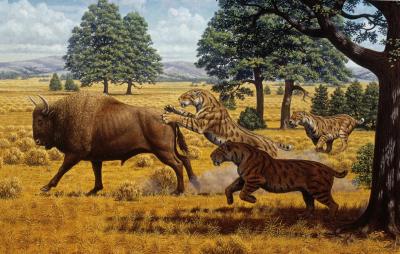Starvation Didn't Wipe Out Sabertooth Cats

Saber-toothed cats apparently did not go extinct for lack of prey, contradicting a popular explanation for why they died off, fossil evidence now suggests.
Even near their extinction, saber-toothed cats likely had enough to eat, researchers noted.
Saber-toothed cats, American lions, woolly mammoths and other giant creatures once roamed across the American landscape. However, at the end of the late Pleistocene about 12,000 years ago, these "megafauna" went extinct, a die-off called the Quaternary extinction.
"The popular theory for the megafaunal extinction is that either the changing climate at the end of the last ice age or human activity, or some combination of the two, killed off most of the large mammals," said researcher Larisa DeSantis, a vertebrate paleontologist at Vanderbilt University in Nashville. "In the case of the great cats, we expect that it would have been increasingly difficult for them to find prey, especially if had to compete with humans. We know that when food becomes scarce, carnivores like the great cats tend to consume more of the carcasses they kill. If they spent more time chomping on bones, it should cause detectable changes in the wear patterns on their teeth."
Tale of the teeth
To learn more about saber-toothed diets, the researchers analyzed the fossil teeth of 15 saber-toothed cats (Smilodon fatalis) and 15 American lions (Panthera atrox) recovered from the La Brea tar pits in Los Angeles. These specimens ranged from about 11,500 to 35,000 years in age.
To study the fossils, the scientists used dental microwear texture analysis, developed by anthropologist Peter Ungar at the University of Arkansas. This involves using generating three-dimensional images of a tooth's surface. The image is then analyzed for microscopic grooves — devouring red meat produces small parallel scratches, while biting on bones lead to larger, deeper pits.
Get the world’s most fascinating discoveries delivered straight to your inbox.
The investigation found the pattern of wear on the teeth of the saber-toothed cat most closely resembled those of present-day African lions, which sometimes crush bone when they eat. The wear pattern on American lion teeth, on the other hand, echoed that of the present-day cheetah, which deliberately avoids bones when it feeds. [Photos: A Lion's Life]
Analysis of both older fossils and more recent ones did not reveal any evidence that patterns of wear changed over time, and none had extreme microwear like living hyenas, which consume entire carcasses, bones included. This suggests that prey for these carnivores was not scarce — the animals were not gnawing their victims to the bone.
"Tooth wear patterns suggest that these cats were not desperately consuming entire carcasses, as was expected, and instead seemed to be living the 'good life' during the late Pleistocene, at least up until the very end," DeSantis said.
Big predator extinction
Past research of teeth from American lions, saber-tooth cats, dire wolves and coyotes from La Brea revealed they experienced three times the number of broken teeth of contemporary predators, hinting that these species were having trouble finding prey and were thus urgently devouring or "processing" whole carcasses. This led scientists to suspect that climate change and human competition were making life tough for the big predators.
Instead, DeSantis and her colleagues argue this high rate of damage seen in teeth more likely resulted during capture of prey instead of feeding on carcasses.
"We expected extinct carnivores to show evidence for extreme bone processing, based on the high number of broken teeth determined from prior research. Finding the complete opposite pattern was shocking!" DeSantis said.
The researchers noted that saber-toothed cats were about the size of today's African lion, while the American lion was about 25 percent larger. They fed on giants such as mammoths and four-ton giant ground sloths. The fact these ancient carnivores and their prey were bigger than contemporary predators and their victims could help explain why the extinct cats had more broken teeth than their living brethren, the investigators said. . [Gallery: Today's Threatened Mammals]
Specifically, larger teeth break more easily than smaller teeth, so larger carnivores may be likely to break more teeth when attempting to take down larger prey. The researchers noted past studies that found the canines of a predator the size of fox can support more than seven times the fox's weight before breaking, while a carnivore the size of lion can only support about four times its weight and the curved teeth of saber-toothed cats could only support about twice the animal's weight.
"The net result of our study is to raise questions about the reigning hypothesis that 'tough times' during the late Pleistocene contributed to the gradual extinction of large carnivores," DeSantis said. "While we can not determine the exact cause of their demise, it is unlikely that the extinction of these cats was a result of gradually declining prey."
Currently, the scientists are examining other carnivores at the La Brea tar pits, "including the extinct giant short-faced bear and the extant mountain lion that is found both during the Pleistocene at La Brea and in southern California and elsewhere today," DeSantis told LiveScience. "Essentially, we are trying to clarify the biology and diets of these carnivores during the past to further evaluate why the short-faced bear went extinct and, potentially, why the mountain lion did not."
DeSantis and Ungar, with their colleagues Blaine Schubert and Jessica Scott, detailed their findings online Dec. 26 in the journal PLOS ONE.
Follow LiveScience on Twitter @livescience. We're also on Facebook & Google+.



